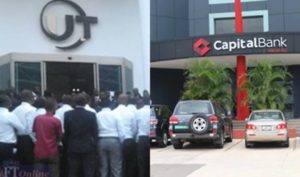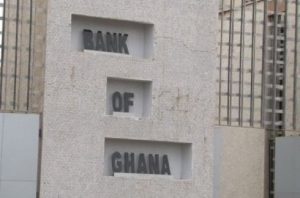
The Bank of Ghana (BoG) has released its latest data on Annual Percentage Rates (APR) of interest charged on loans and credit advances and the Average Interest (AI) paid on deposits by banks.
The APR is the true interest rate banks and non-bank financial institutions charge the public on loans and advances. It reflects the true cost of borrowing and includes charges and commissions levied by banks.
The latest data release is based on figures available as at February 28, 2017 for 31 commercial banks which are currently in full operation in the country.
According to the data, the industry average base rate as at February 28, 2017, was 26.9 percent, a drop of 0.7 percent from the 27.6 percent recorded for the month of January. The average deposit rate dropped from 11.9 percent as at January 31st, 2017 to 11.6 percent during the reporting period.
This is the second consecutive time that the interest rates have dropped marginally this year.
In statement issued in Accra today by Bernard Otabil, Director of Communications of the BoG, it explained: “Average interest paid on deposits is the average interest paid by banks on deposits over the period. Base rate reflects the minimum interest rate that can be charged on loans and advances.”
On base rate which reflects the minimum interest rate that can be charged on loans and advances, UniBank according to the report offered the highest base rate of 42.1 percent on loans and advances it issues to customers, followed by the Royal Bank charging 35.5 percent, Capital Bank charging 33.7 percent, Sahel Sahara (BSIC) charges 32.5 percent, Universal Merchant Bank, Energy Bank and NIB charge 31.6 percent each, HFC charges 30.1 percent, and UT Bank charges 31.0 percent.
In the report the Standard Chartered Bank offers the least base rate at 16.2 percent, followed by Bank of Baroda offers16.9 percent, Stanbic Bank offers 17.4 percent, and Barclays Bank offers 19.9 percent.
The BoG report which 31 banks in the country, also showed some five banks as those who paid the least interest on deposits. They are Energy Bank paying the lowest interest on deposits of 6.4 percent, followed closely by ADB with 6.5 percent, Prudential Bank pays 9.4 percent, CAL Bank pays 9.8 percent, and GCB Bank pays 9.6 percent.
14 banks were found to be offering interests on deposits above the industry average of 11.6 percent while 17 banks also charge above the industry average of 26.9 percent interest charged on loans and credit advances.
Meanwhile, for the true interest charged on loans and advances to households for mortgage purposes, (which also include charges and commissions levied by banks); The Royal Bank offers the highest rate between 35.5 – 40.5 percent. While the Bank of Baroda offers the least between 24.5 – 28.8 percent; below an industry average of 33.6 percent. Seven out of the 31 banks offer interests equal to, or above the average.
Also, enterprises in the agric sector seeking loans for their businesses, are expected to pay an average of 33.0 percent on loans with First Atlantic Bank offering highest rate 41.2 percent, while Bank of Baroda offers the least rate between 24.5 – 28.8 which is below the industry average of 33.2 percent.
In addition, companies within the manufacturing sector that apply for loans from commercial banks pay an average of 35.5 percent which is being offered by 28 banks out of the 31.
On construction, the average annual percentage rate for companies is 33.9 percent with only 27 commercial banks offering construction loans.
The publication of these rates, according to the central bank is to promote transparency in the pricing and provision of banking services. The BoG stated in its statement that it aims to promote accountability of its decision making and build understanding of the monetary policy formulation process among stakeholders through the publication of these documents.
African Eye Report





